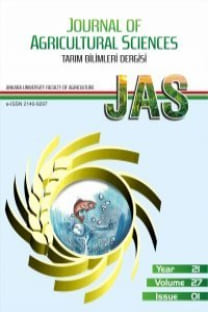Farmland Microclimate and Yield of Winter Wheat under Different Row Spacing
To gain new insights into the underlying mechanisms responsible for farmland microclimate and yield of winterwheat under different row spacings [row spacing: 7 cm (RS7); 14 cm (RS14); 24.5 cm (RS24.5); 49 cm (RS49)],field experiments were conducted at Taian, China. Between the hours 13:00 and 14:00, low values of relativehumidity (RH) and air temperature at 5 cm above the ground for the various row spacings were obtained. Theaverage RH of RS7, RS14, RS24.5, and RS49 was 91.0%, 90.3%, 85.7%, and 76.4%, respectively; the average airtemperature were 22.6°C, 23.2°C, 24.3°C and 25.3°C, respectively. The soil temperature of RS49 was higher thanthose of RS7 and RS14. The maximum values of eddy thermal diffusivity was 0.07 m2 s-1, as well as sensible andsoil heat fluxes, were obtained at 12:00 o’clock. The order of these parameters was similar to that of the airtemperature, but opposite to that of the latent heat flux. The yield of RS49 was significantly lower than those of theother treatments (P < 0.05). The present study indicates that excessive row spacing may result in severe dissipationof energy. RS14 is the optimum condition under uniform planting density.
Farmland Microclimate and Yield of Triticum Aestivum under Different Row Spacing
To gain new insights into the underlying mechanisms responsible for farmland microclimate and yield of winter wheat under different row spacings [row spacing: 7 cm (RS7); 14 cm (RS14); 24.5 cm (RS24.5); 49 cm (RS49)], field experiments were conducted at Taian, China. At approximately 13:00–14:00, low values of RH and air temperature at 5 cm above the ground for the various row spacings were obtained. The average RH of RS7, RS14, RS24.5, and RS49 was 91.0%, 90.3%, 85.7%, and 76.4%, respectively; the order of average air temperature was as follows: RS14 < RS7 < RS24.5 < RS49. The soil temperature of RS49 was obviously higher than those of RS7 and RS14. The maximum values of eddy thermal diffusivity, as well as sensible and soil heat fluxes, were obtained at 12:00. The order of these parameters was similar to that of the air temperature, but opposite to that of the latent heat flux. The yield of RS49 was significantly lower than those of the other treatments (P < 0.05). The present study indicates that increasing the row spacing may result in severe dissipation of energy. RS14 is the optimum condition under uniform planting density.
